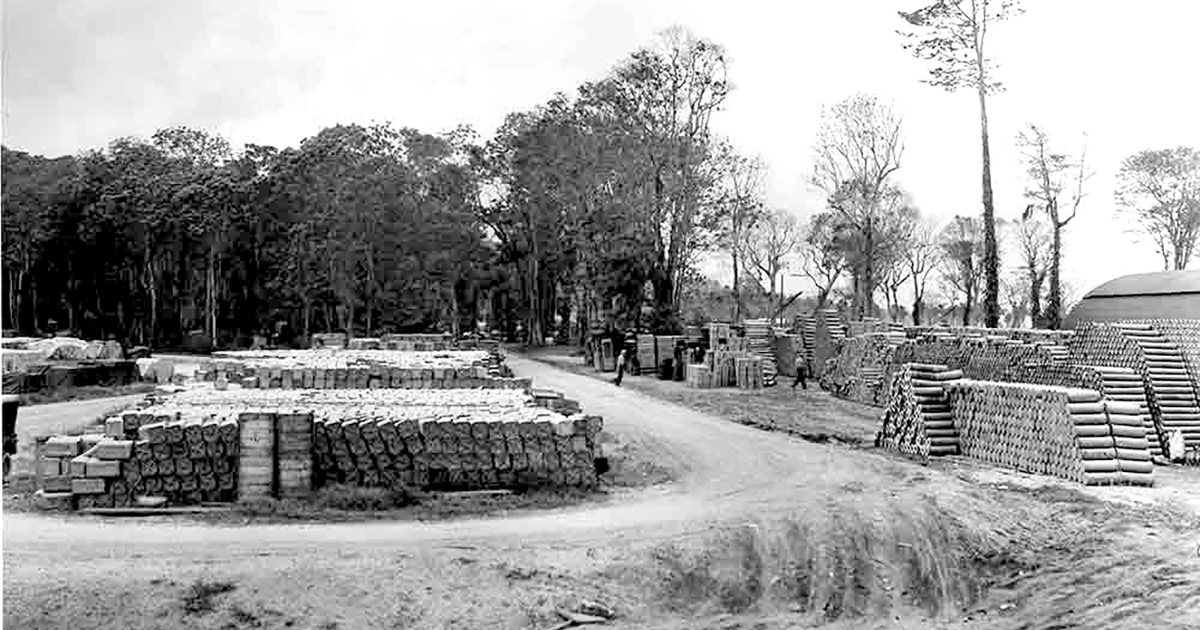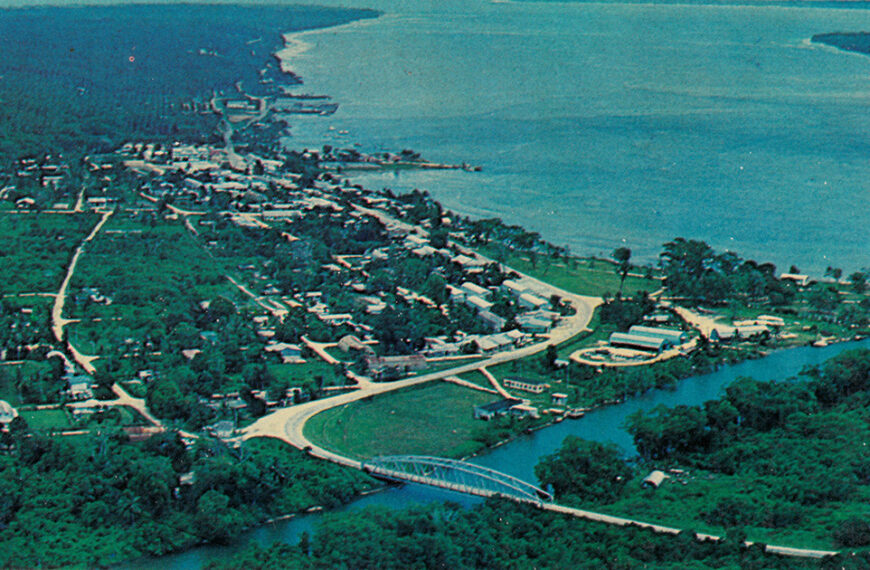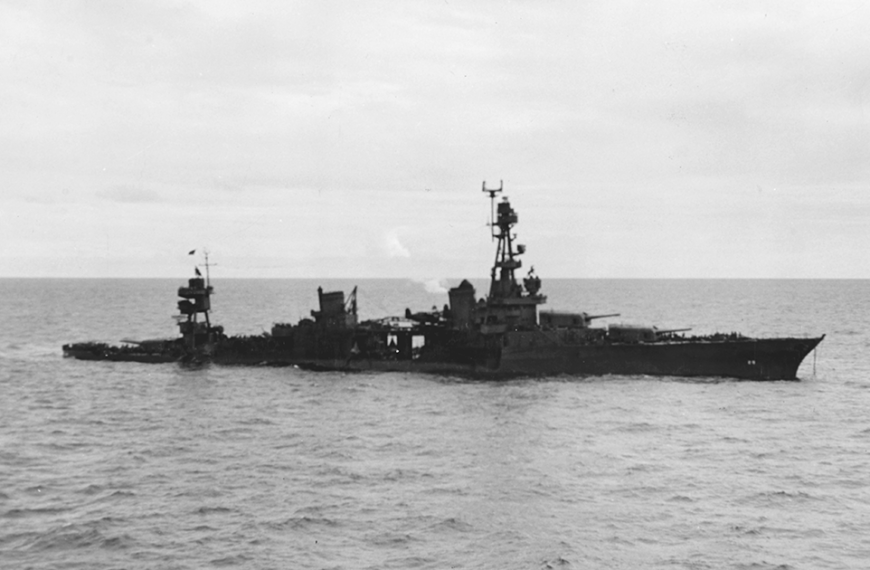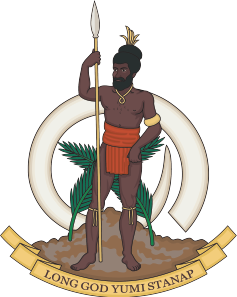Throughout history, many armies have met their demise due to a lack of supplies. The German armies perished in the harsh Russian winter because they were ill-equipped, just like Napoleon’s Grande Armee before them. Logistically, the American forces also faced enormous challenges during World War II. They had to cater to the vast demands of their unprecedentedly large forces and transport supplies and manpower over long distances before they could be effective. Moreover, the Americans had to lease, buy, and construct enough ships to carry the supplies to where they were needed most — the South Pacific, and in this case Espiritu Santo. While most of us have some idea as to what took place on Santo, what exactly was the role of Base Button as far as the U.S. Pacific Fleet was concerned?
By September 1942, the U.S. had established the first of three bomber airfields, secured the harbour entrances with minefields and built up their army strength. Espiritu Santo, a remote island in the Pacific New Hebrides, proved to be the ideal location for an expanded base. With its many square kilometres of suitable ground for a range of activities, it was clearly better than Noumea.
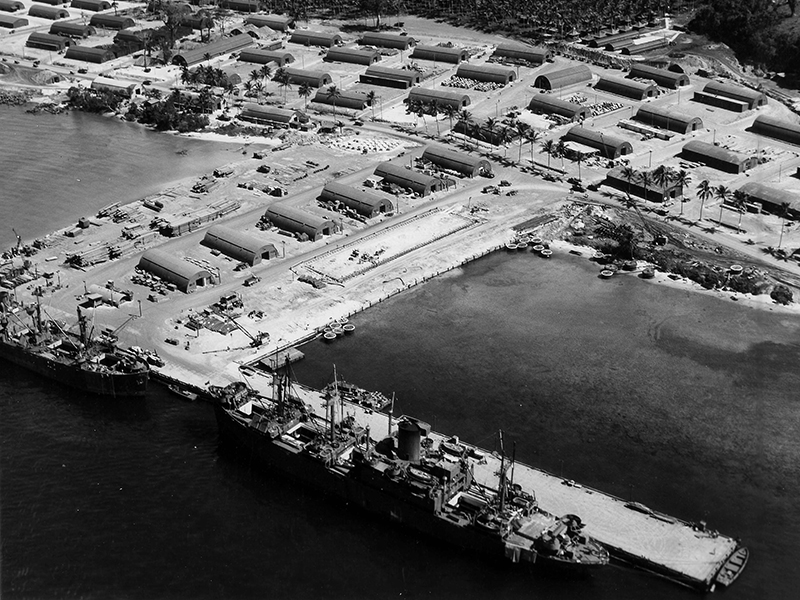
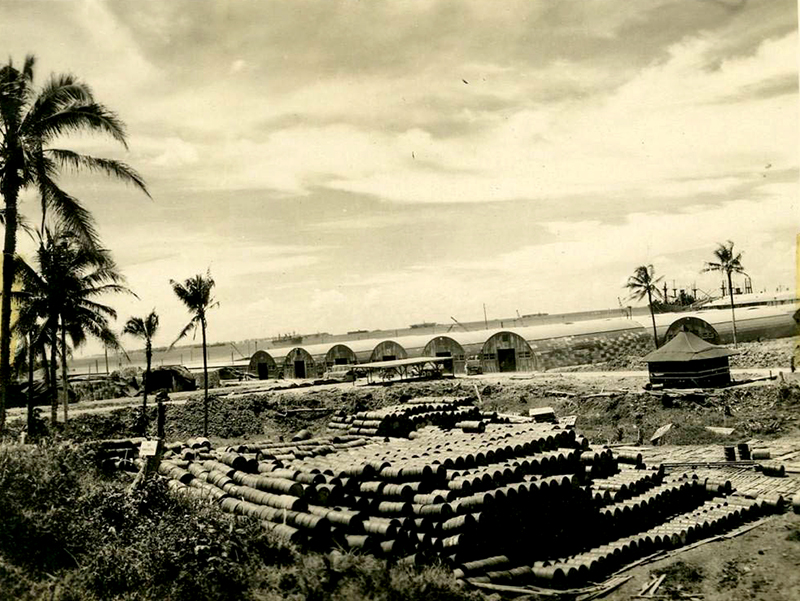
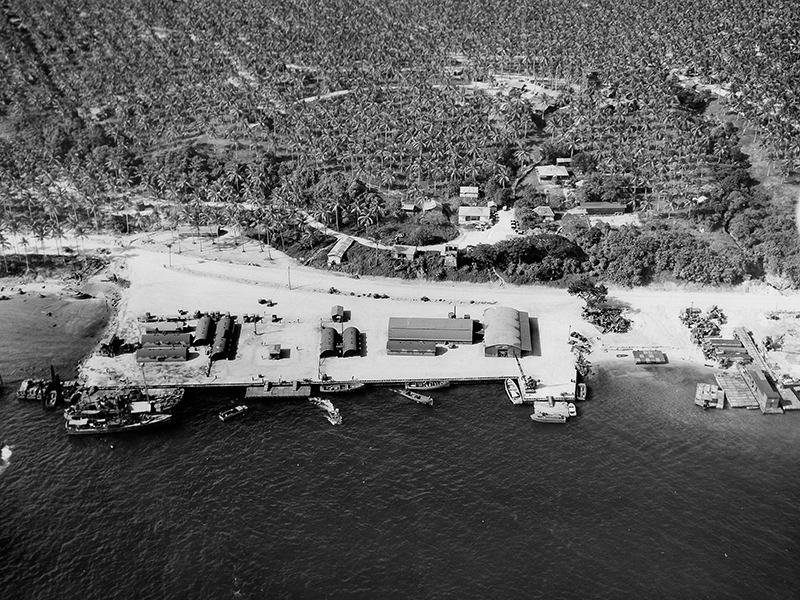
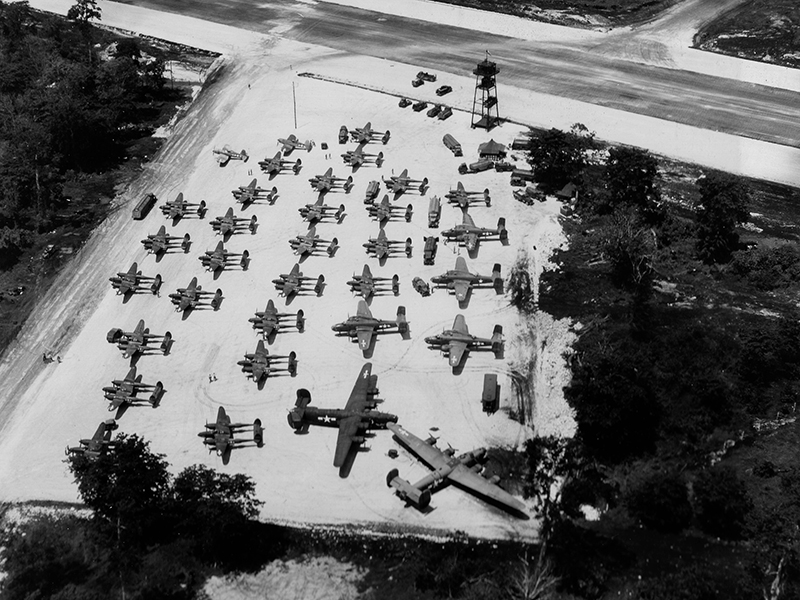
Admiral Halsey soon agreed that Espiritu Santo was the best location for the Americans. He approved the deployment of a ‘Lion,’ a large advanced base unit consisting of all the personnel and material required to establish a major all-purpose naval base. One capable of performing voyage repairs, minor battle damage, and supply functions. The flat-packed base was massive, weighing over 107,000 tons, it took three and a half months to unload from ships, with crews working around the clock.
In the meantime, Halsey stationed cruisers and some destroyers there and sent in the repair ship Rigel to provide them with fuel, dry provisions, and occasionally fresh and frozen provisions. However, the cruisers had very few repair facilities, other than the ship’s force and the overworked Rigel. They had only brought in a limited amount of ammunition for light guns, which had sufficed as they had not engaged in any heavy gun battles. But the situation might soon change, and the call for ammunition for turret guns went out and was immediately shipped.
Fuelling the fleet
By December 1942, several ammunition depots had been set up in Noumea, Espiritu Santo, and Efate to handle aviation ammunition and other materials. Additionally, a fuel-oil storage facility was constructed on Ducos Peninsula in Noumea with a capacity of 370,000 barrels of black fuel and 30,000 barrels of Diesel fuel. A pier was also built where ships could dock and unload supplies.
The demand for oil was constant, as US ships required it to move. At Efate’s Port Vila, there were seven 1,000-barrel steel tanks for aviation gasoline, two 10,000-gallon diesel tanks, and four buried 5,000-gallon aviation-gasoline tanks. At Havannah, there were eight buried tanks that held 5,000 gallons each. The Tulagi area had ten 1,000-barrel tanks and 12,000 barrels of aviation gasoline, a 60,000-barrel diesel-oil storage, and a 280,000-barrel fuel-oil farm. Guadalcanal added storage for 1,300,000 gallons of aviation gasoline.
As the demands for storage increased, the Americans erected fifty 10,000-barrel fuel-oil storage tanks on Aore Island at Santo by July 1943. They also built tanks that could hold 20,000 barrels of diesel fuel, 17,000 barrels of motor gasoline, and twenty-three 1,000-barrel aviation-gasoline tanks. From November 1943, the fuel unit at Santo was one of the busiest supply functions. Previously, the fleet was fuelled by station tankers and incoming oilers. The tank farms and fifty 10,000-barrel storage tanks were connected to a pipeline system and pumps that could handle 350 gallons per minute. Although the amount of oil in storage was not high, it was a significant reserve equivalent to approximately five tanker loads. At its peak early in 1944, the fuel depot issued 3,000 to 5,000 drums of lubricants per month.
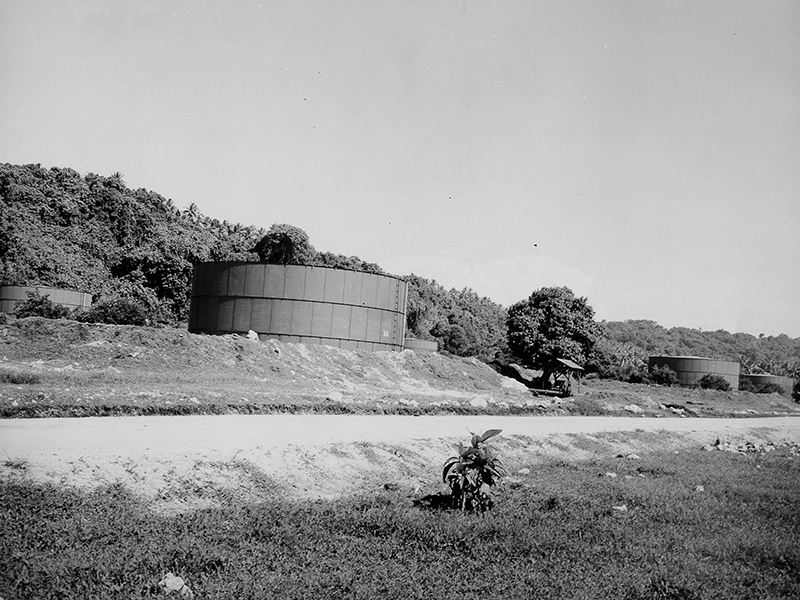
The consumption of fuels and lubricants was enormous. At Tulagi alone, during the early part of 1943, the motor torpedo boats burned 3,000 to 7,000 gallons per day, while the planes burned around 1,000 gallons. By the end of that year, the PT boats consumed approximately 5,000 gallons per day, and the planes consumed 5,000 to 10,000 gallons. Petroleum products carried afloat averaged 219,830 tons, or about 1,300,000 barrels, per month during the first half of 1943, and the amount steadily increased. By October, Commander Service Squadron South Pacific sent a dispatch to Commander Subordinate ‘Command San Francisco saying that his estimate of 17 black-oil tankers was insufficient to meet future requirements. It must be noted that this included both fleet and shore supply, as Service Squadron South Pacific (ServRonSoPac) was responsible for both. This proved that the estimates made in August, only six months prior, were not too large as first thought, but too small.
Ammunition
Cub I, the smaller sibling of Lion I, first established the ammunition supply in Santo. However, it quickly became clear that this depot was inadequate and a much larger facility was required. The first shipment of munitions arrived in December 1942 and, from that point forward, the inventory continued to increase until it reached its pinnacle in September 1944. At that time, there were 38,000 tons of ammunition stored in 175 magazines, Quonset huts, Stransteel warehouses, tents, thatched huts, and open-air dumps.
The depot also overhauled and reconditioned a significant amount of material, including over 40,000 rounds of 5-inch .38 calibre ammunition, with the replacement of the projectile fuses. Until mid-1944, most of the ammunition was directly issued to the waiting ships. As the war progressed westward, this practice dwindled, and ammunition ships were loaded at the depot to move forward with the supply. At the height of its operations in March 1944, the depot serviced 120 vessels, including carriers, heavy and light cruisers, destroyers, destroyer-escort types, landing craft, and the smaller fleet of submarine-chasers and patrol boats. Although not all of these vessels were entirely re-ammunitioned, this was still an impressive achievement, highlighting the importance of the naval base at Espiritu Santo in the logistics of fleet rearming.
Between May 1943 and May 1945, the two officers and 11 men at the torpedo overhaul shop at Santo found themselves somewhat overwhelmed by both fleet and aircraft torpedoes. Of the 2,660 torpedoes received, 2,500 were overhauled and 2,100 reissued. Unfortunately, the quality of their work was not up to par. This was partly due to the rushed and inadequate training of the personnel, partly due to the conditions in which they lived and worked, and partly due to the overwhelming workload under which they operated. A mine depot on Aore Island at Santo assembled and provided sea mines for the protection of the shipping channels. By the time the Santo depot was in full working order, much of the mine-laying and supplying for the South Pacific had already been completed. It was two mines assembled on Aore Island that the SS President Coolidge struck while entering the Segond Channel in October 1942.
By the end of 1943, the Naval Supply Depot at Espiritu Santo was operating 24/7. In August of that year, it serviced its first large task force as a unit, though individual vessels had been taken care of before. Following the initial landings on Bougainville, three large cruisers were sent to Santo — over 900 miles away — for supplies. In short order, they were loaded with 150 tons of provisions and general stores using barges tied up alongside. By late 1943, the supply storage unit, with sixty 40-by-100-foot warehouses and extensive outdoor storage space of around 400,000 square feet, holding supplies of all kinds. The fleet provision unit, with 24 large ‘reefers’ and 5 warehouses, received and issued both fresh and dry provisions, with storage capacity for 2,500 tons of dry and 1,500 tons of fresh and frozen provisions. The incoming stores section was responsible for cargo segregation, and both it and the outgoing stores unit were exceedingly busy.
The supply depot was a product of both planning and trial and error. Over time, it had successfully managed and distributed substantial amounts of supplies, requiring its workforce to work overtime on many occasions. Pier 4, which extended around 200 yards into Segond Channel, was located within the depot and had the capacity to load two large ships simultaneously. However, due to the high demand for supplies, it was often difficult for multiple vessels to dock alongside the busy pier.
In such instances, the ships’ working parties were brought ashore, and trucks were loaded with necessary materials before being driven to an alternative pier. The materials were then unloaded onto barges, which delivered the supplies to the waiting ships by navigating alongside.
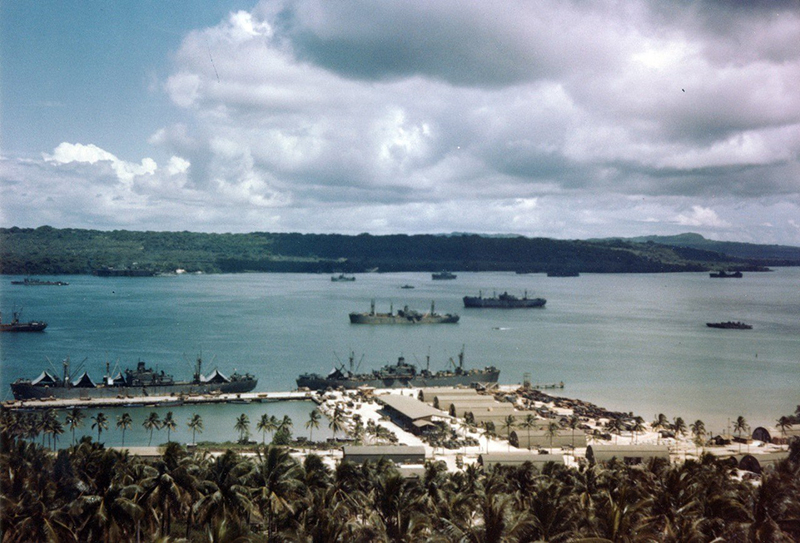
Maintenance and Repair
Naval warfare often results in damaged ships, ranging from minor to severe damage. In order to minimise the impact of this damage, it is important for repair facilities to be located as close as possible to the location of the damage. Only in the most serious cases where local facilities cannot handle the repair, should a combatant vessel be sent back to a navy yard or shipyard. Doing so can take the ship out of the active fleet for an extended period of time, weaken forces, delay pending moves, and leave the damaged ship exposed to further attacks while not in proper fighting condition. During early operations, repair ships and advanced bases did their best to patch up and repair damaged ships. However, floating dry docks were urgently needed to deal with the more severe damage inflicted on ships during battle.
By late 1942, the Americans had installed a ship-repair unit and a floating dry dock, ARD-2, at Noumea. While this floating dock was able to accommodate destroyers, submarines, and Landing Ships, Tank (LST’s), it was small in comparison to the larger ABSD types. ABSD-1 was assembled and put into operation near Aessi Island in Pallikulo Bay. It was an impressive design, and the process of towing and assembling it was a remarkable feat. However, there was some delay in the assembling process as one of its ten sections was lost in the bay, due to an accident that claimed the lives of a number of sailors. Despite this setback, the remaining nine sections were fastened together by December 1943, and the first docking was completed on December 31st. ABSD stands for Advanced Base Sectional Dock, and if fully assembled, ABSD-1 would have been 927 feet long with a lifting capacity of 90,000 tons. As a nine-section dock, it was 844 feet long and could lift 81,000 tons.
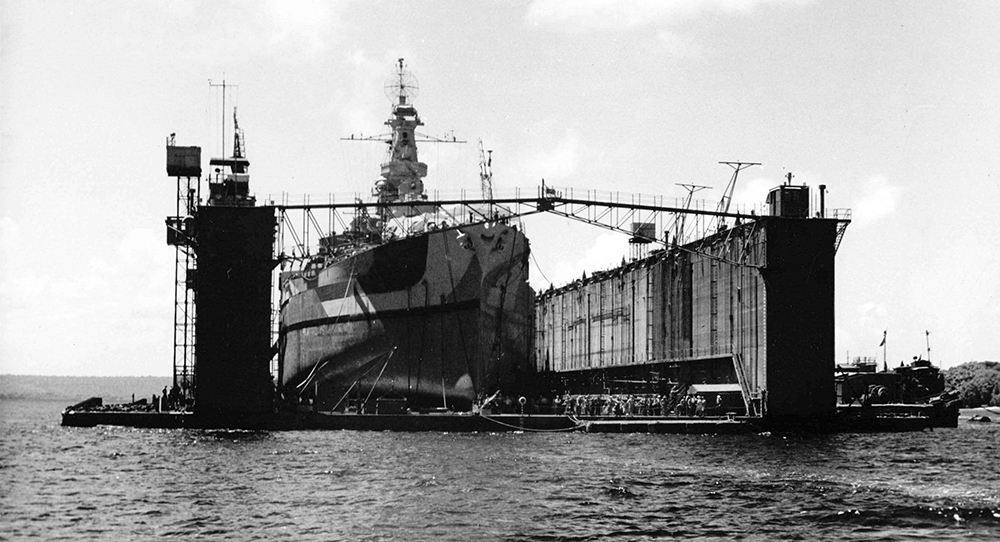
In addition to the ABSD-1 dock at Aessi Island, others were built at Manus Island and Guam. The ABSD-1 was a potential asset, as it was the only dock that could accommodate large, heavy ships operating in the South Pacific. However, it was found that the ABSD-1 dock only docked three ships that could not have been accommodated by the smaller floating docks. The remaining 71 dockings were for medium and smaller vessels. In April of 1945, the ABSD-1 was disassembled and towed to Samar.
The ship-repair unit was operational by the summer of 1943 at Santo, but it was not as large or as capable as some of the other repair facilities. Most of its efforts were focused on necessary routine and emergency repairs to smaller vessels such as patrol craft, auxiliaries, landing craft, merchant ships, and vessels of the United Kingdom. However, it did handle some battle-damage repairs for ships of all types, including fleet destroyers. While much of this repair work was minor, it was done well and with great willingness. In addition to the large dock in Pallikulo Bay, there was also a cruiser-capacity floating dock, YFD-21, and two smaller AFD-14 docks with respective lifting capacities of 3,500 tons.
General Activities
The mission of the service forces extended beyond simply keeping up with the actions of the combat fleet. Their duty was to be proactive in their preparedness to assist before the need was even expressed. This was a daunting but critical task, as it was subject to a vast array of factors beyond American control. Therefore, any account of their work cannot be entirely objective. The combat forces gained more confidence and boldness as they realised they had fast access to necessary resources in both victory and defeat.
The fleet provision unit provided 24 large reefers and 5 warehouses in Santo, and 10 ships were stationed in Auckland to transport vital supplies wherever they were needed. Even with these efforts, it was still insufficient as demand grew. In September 1943, the Commanding Officer of Service Squadron South Pacific estimated that he had only half the ships required to carry the provisions contracted for in New Zealand for 1944.
For some time, Auckland was the primary supply base and was able to meet the requisitions made of it. However, by the time they arrived at Guadalcanal, it was clear that New Zealand was too far away to be a direct supply base for the fleet. From that moment on, the principal supply to the fleet was made by United States’ provisions ships and the supply depots on advanced bases at Noumea and Santo. However, Auckland continued to provide large amounts of food to the shore forces.
As demand grew, more supplies were required daily. In May 1943, it was reported that they needed 17 additional tugs, two more fuel-oil barges, and five gasoline barges to supplement the four on hand. A month later, they requested an additional nine diesel-engine repair ships, three aviation stores ships, two destroyer tenders, six LSTs as aviation stores issue ships, four landing-craft repair ships, one landing-craft tender, 10 tugs, and 60 LCVPs per month for six months. In addition, they required three big salvage tugs and two motor-torpedo-boat tenders. This was a period when the benefits of floating services were becoming increasingly evident. There were also smaller facilities located in Noumea and Santo, such as the fleet post offices, an antiaircraft gunnery school, a fire-fighting school, a motion-picture exchange, and gas plants, among others.
All of these facilities contributed to the creation of major bases, such as Base Button, which quickly found themselves too far behind the front lines. This raised the question of whether the shipping required to build them could have been better used to provide the necessary fleet support afloat, which could have been mobile and ready to move forward at a moment’s notice.
This line of thought led to the establishment of floating mobile service squadrons and other logistical support groups. These floating organisations remained close to the combat fleet, supplying food, ammunition, and other essentials while providing repair services in close proximity to the combat areas. This support allowed the fleet to maintain continuous pressure on the enemy by avoiding the need to return to home bases. Service Squadrons created temporary forward bases to enable the naval squadrons to spend less time in transit and more time in the combat zone.
The contribution of Base Button during the Pacific conflict was pivotal in bolstering the efforts of the United States Pacific Fleet and its allies. The successful execution of military operations depended heavily on maintenance, repair, and supply provided by the major bases. Had it not been for their exceptional level of support, the outcome of the war might have been drastically altered. It is impossible to overstate the significance of Base Button’s role in the success of the Pacific conflict.
